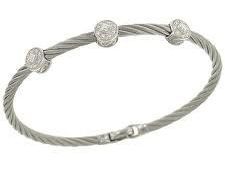 Los Angeles, CA – A’lor International sued numerous jewelry designers, producers and retailers for copyright and trade dress infringement over sales various nautical twisted cable motif jewelry. A’lor filed a summary adjudication motion asking the Court to deem Defendants liable for copyright and trade dress infringement. Defendant Lau filed a motion for partial summary judgment that it did not infringe A’lor’s copyrights and Defendant Miami Lakes filed a motion regarding the trade dress infringement claims, which motions were joined by several defendants.
Los Angeles, CA – A’lor International sued numerous jewelry designers, producers and retailers for copyright and trade dress infringement over sales various nautical twisted cable motif jewelry. A’lor filed a summary adjudication motion asking the Court to deem Defendants liable for copyright and trade dress infringement. Defendant Lau filed a motion for partial summary judgment that it did not infringe A’lor’s copyrights and Defendant Miami Lakes filed a motion regarding the trade dress infringement claims, which motions were joined by several defendants.
To succeed on its copyright infringement claims, Plaintiff must show that (1) Plaintiff owns valid copyrights in the Subject Designs; and (2) Defendants infringed on Plaintiff’s copyright. Lamps Plus, Inc. v. Seattle Lighting Fixture Co., 345 F.3d 1140 (9th Cir. 2003). The Court held that A’lor’s copyright registration certificates constituted prima facie evidence of a valid copyright, which presumption of validity defendants were unable to rebut. 17 U.S.C. § 410(c). To rebut the presumption, Defendants argued that the copyrights were invalid because they lack originality. Satava v. Lowry, 323 F.3d 805, 811 (9th Cir. 2003). The Court, however, found that Defendants submitted evidence of pre-existing nautical twisted cable motif jewelry sold by third parties and to provide copyright protection to Plaintiff’s would improperly give Plaintiff a monopoly on nautical rope band jewelry. Nevertheless, the Court found that Plaintiff was entitled to a “thin” copyright in the style of the clasp or other ornaments and panther heads. But once the court subtracted the unoriginal elements and considered only Plaintiff’s original contributions, no copyright infringement could be found because virtually identical copying didn’t exist, the proper infringement test for a “thin” copyright.
Regarding its trade dress infringement claim, A’lor had to show that (1) the trade dress is nonfunctional; (2) the trade dress has acquired secondary meaning, and (3) there is a substantial likelihood of confusion between the Accused Designs and the Subject Designs. See Art Attacks v. MGA Entertainment, Inc., 581 F.3d 1138, 1145 (9th Cir. 2009). “Trade dress” refers to the “total image of a product” and may include features such as size, shape, color, color combinations, texture or graphics. International Jensen, Inc. v. Metrosound U.S.A., Inc., 4 F.3d 819, 822 (9th Cir. 1993). Because the scope of trade dress protection may be broad, courts exercise particular caution when extending protection to product designs, as granting trade protection to an ordinary product design would create a monopoly in the goods themselves. Landscape Forms, Inc. v. Columbia Cascade Co., 113 F.3d 373, 380 (2d Cir. 1997).
A’lor described its trade dress as “interwoven nautical cable threads composed of twisted stainless steel wire forming single- or juxtaposed multi-strand treated cable threading with soft-textured adornments and embellishments spaced through the cable.” The Court found the definition to be amoebic, namely “impermissibly general and overbroad…As such, extending protection to this trade dress would permit Plaintiff to exclude competition from functionally similar products that use stainless steel in nautical cable band jewelry…Therefore, the Court finds that the trade dress, as articulated by Plaintiff, is no more than a concept or idea.”
The case is A’lor International, Ltd. v. Tappers Fine Jewelry, Inc., CV12-02215 RGK (C.D. Cal. 2012).
Read a jewelry patent attorney‘s more detailed article on how to protect jewelry through both design patents and utility patents when copyright and/or trademark protection is unavailable.
 Los Angeles Intellectual Property Trademark Attorney Blog
Los Angeles Intellectual Property Trademark Attorney Blog

